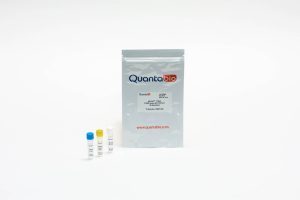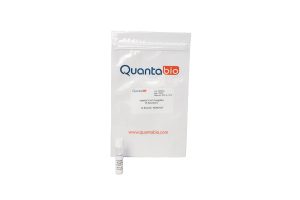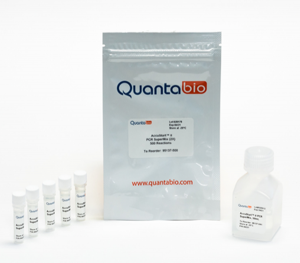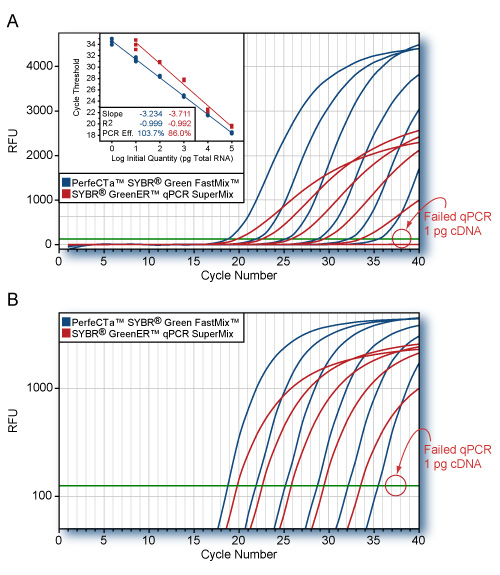Perfecta SYBR Green Fast Mix
| Product | Kit Size | Order Info |
|---|---|---|
| PerfeCTa SYBR Green FastMix for IQ | 250 x 20 μL rxns (2 x 1.25 mL) | Order (95071-250) |
| 1250 x 20 μL rxns (10 x 1.25 mL) | Order (95071-012) | |
| 5000 x 20 μL rxns (1 x 50 mL) | Order (95071-05K) | |
| PerfeCTa SYBR Green FastMix | 250 x 20 μL rxns (2 x 1.25 mL) | Order (95072-250) |
| 1250 x 20 μL rxns (10 x 1.25 mL) | Order (95072-012) | |
| 5000 x 20 μL rxns (1 x 50 mL) | Order (95072-05K) | |
| PerfeCTa SYBR Green FastMix ROX | 250 x 20 μL rxns (2 x 1.25 mL) | Order (95073-250) |
| 1250 x 20 μL rxns (10 x 1.25 mL) | Order (95073-012) | |
| 5000 x 20 μL rxns (1 x 50 mL) | Order (95073-05K) | |
| PerfeCTa SYBR Green FastMix Low ROX | 250 x 20 μL rxns (2 x 1.25 mL) | Order (95074-250) |
| 1250 x 20 μL rxns (10 x 1.25 mL) | Order (95074-012) | |
| 5000 x 20 μL rxns (1 x 50 mL) | Order (95074-05K) |
Documents
Description
Features & Benefits
- 2x concentrated reagents minimize pipetting steps, simplify reaction assembly and improve accuracy
- Superior assay sensitivity and specificity with ultrapure AccuStart enzyme technology – maximum-yielding Taq DNA polymerase mutant controlled by stringent, multi-epitope antibody hot start
- Supports efficient vortex mixing with proprietary anti-foaming formulation
- FastMix formulation supports both fast and standard thermal cycling conditions
Description
PerfeCTa SYBR Green FastMix is a 2X concentrated, ready-to-use reaction cocktail that contains all components, except primers and DNA template. This rigorously optimized master mix contains of proprietary buffer technology, stabilizers and AccuFast Taq DNA polymerase to deliver maximum assay precision, sensitivity, and PCR efficiency for accelerated or conventional thermal cycling conditions for SYBR Green detection. Dye-based detection methods are critically dependent on highly specific amplification because dsDNA dyes will bind to any amplicon, including off-target primer elongation and primer dimerization. AccuFast hot start Taq DNA polymerase contains a proprietary mixture of ultra-pure monoclonal antibodies that stringently suppress primer elongation prior to the initial PCR denaturation step and allows for setup and multi-day storage at ambient room temperature prior to thermal cycling. AccuFast provides rapid release of fully active enzyme to support accelerated thermal cycling conditions.
Applications
Single-tube, 2X concentrated reagent containing:
- Reaction buffer with optimized concentrations of molecular-grade MgCl2, dATP, dCTP, dGTP, and dTTP.
- AccuStart II Taq DNA Polymerase
- SYBR Green I dye
- Proprietary enzyme stabilizers and performance-enhancing additives.
- Titrated reference dye (if applicable)
Store components in a constant temperature freezer at -25°C to -15°C protected from light upon receipt. After thawing, mix thoroughly before using. For lot specific expiry date, refer to package label, Certificate of Analysis or Product Specification Form.
| ROX | Low ROX | No ROX | Bio-Rad iCycler iQ systems |
| Applied Biosystems 5700 | Applied Biosystems 7500 | Quantabio Q | BioRad iCycler iQ™ |
| Applied Biosystems 7000 | Applied Biosystems 7500 Fast | BioRad CFX | BioRad MyiQ™ |
| Applied Biosystems 7300 | Stratagene Mx3000P® | Roche LightCycler 480 | BioRad iQ™5 |
| Applied Biosystems 7700 | Stratagene Mx3005P™ | QIAGEN Rotor-Gene Q | |
| Applied Biosystems 7900 | Stratagene Mx4000™ | Other | |
| Applied Biosystems 7900HT | Applied Biosystems ViiA 7 | ||
| Applied Biosystems 7900 HT Fast | Applied Biosystems QuantStudio™ | ||
| Applied Biosystems StepOne™ | Agilent AriaMx | ||
| Applied Biosystems StepOnePlus™ | Douglas Scientific IntelliQube® |
Product Flyers
Product Manuals
FAQs
Q1. Can I use PerfeCTa® SYBR® Green FastMix® instead of SYBR Green SuperMix?
You can use FastMix instead of SuperMix. We have observed similar results with both PCR mixes, however, slightly lower background was observed using SuperMix when using 10 ng of cDNA or more in the qPCR. The qScript microRNA Quantification system has been validated using SYBR Green SuperMix.
Q2. We use Perfecta Sybr Green Fastmix. We are starting to use uMELT software to predict qPCR melt curves. Could you please provide me with this info so that I can accurately use uMELT? [Mono+] : Concentration of monovalent cations in solution (mM).
The PerfeCta SYBR Green Fastmix has 50 mM salt and 2.2mM Free Mg at 1X. However, the co-solvents and the concentration of SYBR green I dye in the mastermix also affect amplicon Tm, so you may still not be able to accurately use uMELT. Our R&D has found uMELT mostly useful for predicting multiple melting domains in an amplicon.
Publications
Kayla J. Smith, Toxicology – 2017
ABSTRACT
The mouse strain SKH1 is widely used in skin research due to its hairless phenotype and intact immune system. Due to the complex nature of aryl hydrocarbon receptor (AHR) function in the skin, the development of additional in vivo models is necessary to study its role in cutaneous homeostasis and pathology. Variants of the Ah allele, exist among different mouse strains. The Ahb−1 and Ahd alleles express high and low affinity ligand binding forms of the AHR, respectively. The outbred SKH1 mice express the Ahb−2 and/or Ahd alleles. SKH1 mice were crossed with C57BL/6J mice, which harbor the Ahb−1 allele, to create useful models for studying endogenous AHR function. SKH1 mice were bred to be homozygous for either the Ahb−1 or Ahd allele to establish strains for use in comparative studies of the effects of differential ligand-mediated activation through gene expression changes upon UVB exposure. Ahb−1 or Ahd allelic status was confirmed by DNA sequence analysis. We tested the hypothesis that SKH1-Ahb−1 mice would display enhanced inflammatory signaling upon UVB exposure compared to SKH1-Ahd mice. Differential basal AHR activation between the strains was determined by assessing Cyp1a1 expression levels in the small intestine, liver, and skin of the SKH1-Ahb−1 mice compared to SKH1-Ahd mice. To determine whether SKH1-Ahb−1 mice are more prone to a pro-inflammatory phenotype in response to UVB, gene expression of inflammatory mediators was analyzed. SKH1-Ahb−1 mice expressed enhanced gene expression of the chemotactic factors Cxcl5, Cxcl1, and Ccl20, as well as the inflammatory signaling factors S100a9 and Ptgs2, compared to SKH1-Ahd mice in skin. These data supports a role for AHR activation and enhanced inflammatory signaling in skin.
Fine-scale spatial and temporal dynamics of kdr haplotypes in Aedes aegypti from Mexico
Marissa K. Grossman, BMC – 2019
ABSTRACT
Background As resistance to insecticides increases in disease vectors, it has become exceedingly important to monitor populations for susceptibility. Most studies of field populations of Aedes aegypti have largely characterized resistance patterns at the spatial scale of the city or country, which may not be completely informative given that insecticide application occurs at the scale of the house or city block. Phenotypic resistance to pyrethroids dominates in Ae. aegypti, and it has been partially explained by mutations in the voltage-gated sodium channel gene. Here, we assess community-level patterns of four knockdown resistance (kdr) haplotypes (C1534/I1016, F1534/I1016, C1534/V1016 and F1534/V1016) in Ae. aegypti in 24 randomly chosen city blocks from a city in Yucatán State, Mexico, during both the dry and wet season and over two years. Results Three of the four haplotypes, C1534/I1016, C1534/V1016 and F1534/V1016 were heterogeneous between city blocks at all four sampling time points, and the double mutant haplotype, C1534/I1016, showed a significant increase following the wet season. The F1534/I1016 haplotype was rarely detected, similar to other studies. However, when haplotype frequencies were aggregated to a coarser spatial scale, the differences in space and time were obscured. Conclusions Our results provide empirical evidence that the selection of kdr alleles is occurring at fine spatial scales, indicating that future studies should include this scale to better understand evolutionary processes of resistance in natural populations.
Uptake and biological responses in land snail Cornu aspersum exposed to vaporized CdCl2
L. Sturba, Ecotoxicology and Environmental Safety – 2017
ABSTRACT
The uptake of Cd and some biomarkers of exposure and effects have been investigated in specimens of land snail Cornu aspersum exposed to vaporized CdCl2 (10mg/L) for 7 days. The Cd levels quantified in snail’s whole bodies confirmed Cd bioavailability trough vaporization and an higher accumulation in the midgut gland compared to the foot. Biological responses investigated showed a reduction of destabilization time of lysosomal membranes (NRRT) in hemocytes and an induction of catalase activities (CAT) in midgut gland. A further evidence of CdCl2 vaporized exposure was given by an increase in MT protein content as well as induction of Cd-MT gene expression, highlighting the central role of the midgut gland in Cd detoxification. These biomarkers can thus be considered as sensitive tools for the assessment of Cd contamination in the air using land snails as bioindicators. No changes in of GST activity and MDA were observed. From the overall results, the land snail, C. aspersum, could be used as good bioindicator of air quality for pollution monitoring purposes having shown clear signs of exposure and effects due Cd exposure by air.
Dongwon Kim, Molecular Reproduction and Development – 2018
ABSTRACT
Recruitment of a single follicle into the preovulatory hierarchy of the domestic hen ovary occurs from a small cohort of prehierarchal follicles measuring 6-8 mm in diameter. We have previously reported that granulosa cells (GC) collected from prehierarchal follicles express highest levels of membrane-localized follicle-stimulating hormone receptor (FSHR) during follicle development, yet fail to initiate signaling via cAMP following short-term incubation with FSH. Consequently, GC from prehierarchal follicles remain in an undifferentiated state and lack the capacity for steroidogenesis due to a deficiency of cAMP-dependent STAR protein and CYP11A1 gene expression. The present studies investigate FSH responsiveness in GC before and after the transition from undifferentiated to a differentiated state at follicle recruitment. Prior to recruitment focus is directed towards the inhibition of FSHR signaling by β-ARRESTIN (βARR). Specifically, knockdown of βARR mRNA in cultured, undifferentiated GC using small interfering RNA (siRNA) facilitated FSH-induced cAMP formation, STAR expression and progesterone production. Furthermore, over-expression of bovine βARR1 and G PROTEIN-COUPLED RECEPTOR KINASE2 in actively differentiating GC significantly decreased cAMP accumulation and progesterone production following a challenge with FSH. We propose that a βARR-mediated mechanism maintains FSHR unresponsiveness in undifferentiated GC from prehierarchal follicles, and as a result prevents GC differentiation until the time of follicle recruitment. This article is protected by copyright. All rights reserved.
Increased Alternative Splicing as a Host Response to Edwardsiella ictaluri Infection in Catfish
Suxu Tan, Marine Biotechnology – 2018
ABSTRACT
Alternative splicing is the process of generating multiple transcripts from a single pre-mRNA used by eukaryotes to regulate gene expression and increase proteomic complexity. Although alternative splicing profiles have been well studied in mammalian species, they have not been well studied in aquatic species, especially after biotic stresses. In the present study, genomic information and RNA-Seq datasets were utilized to characterize alternative splicing profiles and their induced changes after bacterial infection with Edwardsiella ictaluri in channel catfish (Ictalurus punctatus). A total of 27,476 alternative splicing events, derived from 9694 genes, were identified in channel catfish. Exon skipping was the most abundant while mutually exclusive exon was the least abundant type of alternative splicing. Alternative splicing was greatly induced by E. ictaluri infection with 21.9% increase in alternative splicing events. Interestingly, genes involved in RNA binding and RNA splicing themselves were significantly enriched in differentially alternatively spliced genes after infection. Sequence analyses of splice variants of a representative alternatively spliced gene, splicing factor srsf2, revealed that certain spliced transcripts may undergo nonsense-mediated decay (NMD), suggesting functional significance of the induced alternative splicing. Although statistical analysis was not possible with such large datasets, results from quantitative real-time PCR from representative differential alternative splicing events provided general validation of the bacterial infection-induced alternative splicing. This is the first comprehensive study of alternative splicing and its changes in response to bacterial infection in fish species, providing insights into the molecular mechanisms of host responses to biotic stresses.
Safety Data Sheets (SDS)
CofA (PSF)
PSF-95072-012-Lot#019930
PSF-95072-250-Lot#020128
PSF-05056-100-Lot#022134
PSF-95071-012-Lot#022029
PSF-95071-012-Lot#022697
PSF-95071-012-Lot#023121
PSF-95072-012-Lot#020876
PSF-95072-012-Lot#021570
PSF-95072-012-Lot#022023
PSF-95072-012-Lot#022655
PSF-95072-05K-Lot#022633
PSF-95072-05K-Lot#022997
PSF-95072-250-Lot#022654
PSF-95073-012-Lot#021827
PSF-95073-012-Lot#022229
PSF-95073-012-Lot#022230
PSF-95073-012-Lot#022231
PSF-95073-012-Lot#023336
PSF-95073-05K-Lot#023337
PSF-95073-125-Lot#023334
PSF-95073-250-Lot#021753
PSF-95073-250-Lot#023335
PSF-95074-012-Lot#021885
PSF-95074-012-Lot#022048
PSF-95074-012-Lot#022506
PSF-95074-012-Lot#022507
PSF-95074-05K-Lot#022656
PSF-95074-05K-Lot#022948
PSF-95074-125-Lot#022996
PSF-95074-250-Lot#022594
PSF-95074-250-Lot#023453
PSF-95072-250-Lot#023547
PSF-95074-012-Lot#023505
PSF-95072-012-Lot#023782
PSF-95072-05K-Lot#023781
PSF-95072-250-Lot#022654
PSF-95074-05k-Lot#023956
PSF-95080-500-Lot#023125
PSF-95073-012-Lot#024035
PSF-95073-05K-Lot#024036
PSF-95073-250-Lot#024034
PSF-95074-250-Lot#024290
PSF-95081-100-Lot#024317
PSF-95072-05K-Lot#025148
PSF-95073-05K-Lot#025374
PSF-95073-250-Lot#025393
PSF-95074-012-Lot#025412
PSF-95071-250-Lot#025600
PSF-95074-05k-Lot#025812
PSF-95074-250-Lot#025601
PSF-95079-500-Lot#025602
PSF-95080-500-Lot#025603
PSF-95071-250-Lot#025600
PSF-95074-05k-Lot#025812
PSF-95074-250-Lot#025601
PSF-95079-500-Lot#025602
PSF-95080-500-Lot#025603
PSF-95072-05K-Lot#025933
PSF-95072-012-Lot#026309
PSF-95072-250-Lot#026308
PSF-95073-012-Lot#026333
PSF-95073-012-Lot#026334
PSF-95072-05K-Lot#026310
PSF-95073-05K-Lot#026331
PSF-95074-012-Lot#026596
PSF-95080-500-Lot#026666
PSF-95074-05K-Lot#026602
PSF-95079-500-Lot#026599
PSF-95079-500-Lot#026600
PSF-95073-012-Lot#026977
PSF-95072-012-Lot#027282
PSF-95072-012-Lot#027284
PSF-95072-012-Lot#027285
PSF-95072-250-Lot#027280
PSF-95074-250-Lot#027168
PSF-95080-500-Lot#027292
PSF-95071-250-Lot#027454
PSF-95072-05K-Lot#027286
PSF-95073-05K-Lot#027441
PSF-95071-05K-Lot#027599
PSF-95073-250-Lot#027517
PSF-95074-012-Lot#027583
PSF-95074-012-Lot#028144
PSF-95074-250-Lot#028143
PSF-95074-05K-Lot#028313
PSF-95071-250-Lot#028421
PSF-95072-250-Lot#028512
PSF-95073-05K-Lot#028565
PSF-95073-250-Lot#028423
PSF-95074-250-Lot#028456
PSF-95072-012-Lot#028888
PSF-95072-012-Lot#028945
PSF-95071-012-Lot#029555
PSF-95071-05K-Lot#029397
PSF-95074-05K-Lot# 029219
PSF-95071-05K-Lot#029821
PSF-95072-012-Lot#029907
PSF-95073-012-Lot#029954
PSF-95072-250-Lot#030038
PSF-95073-250-Lot#030086
PSF-95074-05K-Lot#030178
PSF-95071-250-Lot#030445
PSF-95072-012-Lot#030447
PSF-95074-05K-Lot#030268
PSF-95072-012-LOT#66139894
PSF-95074-012-LOT#66139494
PSF-95073-012-LOT#66140404
PSF-95073-250-LOT#66140230
PSF-95071-012-LOT#66141023
PSF-95071-05K-LOT#66141025
PSF-95071-250-LOT#66141024
PSF-95073-05K-LOT#66141026
PSF-95074-250-LOT#66141354
PSF-95080-500-LOT#66141357
PSF-95072-250-LOT#66141353
PSF-95071-012-LOT#66143120
PSF-95072-05K-LOT#66148489
PSF-95074-05K-LOT#66148057
PSF-95071-012-LOT#66148815
PSF-95073-05K-LOT#66148816
PSF-95074-250-LOT#66148965
PSF-95074-250-LOT#66148966
PSF-95079-500-LOT#66149316
PSF-95081-100-LOT#66149360
PSF-95072-05K-LOT#66151991
PSF-95072-250-LOT#66151213
PSF-95079-500 -LOT#66151667
PSF-95080-500-LOT#66151045
PSF-95072-05K-LOT#66153010
PSF-95071-05K-LOT#66154760
PSF-95072-012-LOT#66154127
PSF-95079-100-LOT#66154983
PSF-95071-250-LOT#66155304
PSF-95072-05K-LOT#66155422
PSF-95079-500-LOT#66155053
PSF-95071-012-LOT#66155744
PSF-95073-012- Lot#66155746
PSF-95074-012-LOT#66154990
PSF-95074-012-LOT#66154990










